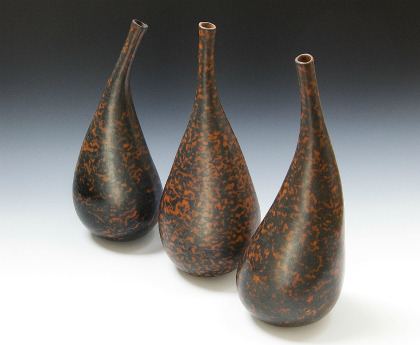
What is your present project, what’s its history and how do you make the pieces?
I am exploring using soluble metal salts on low-fired porcelain clay, a project I began two years ago and am just now achieving the effects I desire. All of my work is hand coiled, then carefully burnished to a smooth finish. I bisque fire the clay at earthenware temperatures, paint them with water soluble metals – iron, nickel, cobalt and other salts, and fire again at low temperatures.
Ceramics Now Magazine: Where do you get your inspiration for your pieces and what motivates you?
I seek to create work that evokes a sense of wonder and mystery, forms that beckon to be held and admired. I delight in closely observing and then interpreting natural objects and events – weathered boulders on a mountain slope, wind ripples on a gray blue sea, complex designs on a delicate bird egg – their rhythms, patterns and forces have greatly inspired my work. I am an avid traveler and hiker. During my adventures, I have discovered the magnificent pottery of ancient cultures in the American Southwest, South America, and Asia, which speak to me in very profound ways.
In what techniques do you usually work and what materials do you use? Do you find working with soluble salts hard?
I have been experimenting with soluble metal salts for the past two years, a collaboration with my husband, Mark Goudy, which draws on the inspirational work of the master of soluble metals, Arne Åse. Through trial and error, I have developed my own techniques for applying these almost transparent, highly sensitive “watercolors.” The chemicals are toxic, and care must be taken while working with them, so my experiences working with photography chemicals and in a scientific laboratory have been extremely helpful. Although metal salts are challenging to work with, I love the sense of anticipation as I wait for a kiln load to finish firing, the joy of seeing their almost magical effects. Some results are disappointing, but I enjoy challenges. Because working with metal salts requires continual testing, inventing and learning, I am certain this project will keep me engaged for quite a long while.
How did it all start? Do you remember your early works?
I did my first work in clay during high school and was excited to experiment with raku firing, a technique that was just becoming popular at that time. I enrolled in college as an art major, but my passion for nature and wilderness soon led me in another direction – acquiring land to protect wild areas and create parks throughout California and the western United States.
My early passion for ceramics was rekindled five years ago when I participated in a raku firing, and I have been working in clay ever since. Because I am a haptic person who responds to the sensation of touching – it helps me explore and enjoy my work – I am drawn to processes that color and pattern the clay without applying a glaze to the surface. My early pieces were smoke-fired, using raku, saggar, and pit firing techniques, fumed with oxides and salts. I enjoyed these processes but soon felt that the color palette was too limited and sought alternative techniques. When I discovered Arne Åse’s book, Water Colour on Porcelain, I realized that soluble metal salts, which permeate the clay body, would expand the colors and patterns available to me. By firing my pieces at low temperatures, I am able to preserve the silky smooth feel of the burnished clay.

Three Vessels – View her works
How important are details and decorations for you?
I am a patient, perhaps obsessive person and spend many hours constructing and decorating each piece, striving to make every detail seamlessly integrated. For me, a successful piece casts an elegant shadow, feels like a weathered pebble from the shore, and has surface decoration that mimics and celebrates the colors and patterns of nature.
Where can we find you and your works in the future
My studio is in Berkeley, California. I have shown my work in venues throughout California and am exploring options nationally and internationally. Please visit my website to see my current work at http://www.thundercloudstudio.com

Vessel – View her works
Give advice for young ceramic artists.
Never let go of your dreams. For years I dreamed of devoting my time to art but spent most of my career in other professions – I was a park ranger, a director for a conservation organization, a lab technician. I explored photography as my artistic expression; I traveled around the world. Now that I have returned to ceramics, I find my past experiences influence my artistic sense, my way of seeing, and I now draw on a unique set of skills that have proven invaluable to my current work as a ceramic artist.
“I have been deeply inspired by the rhythm, patterns and forces of life, boulders on a Sierra slope, the sensual shoulder line of a human figure, wind ripples on a gray blue sea and, during extensive travels around the world, by the ceramic work of ancient cultures, carefully crafted work that speaks to me, perhaps from the maker’s spirit still residing in the artifacts themselves.
I draw on the same techniques these cultures used to hand coil my vessels, using smooth porcellaneous clay. Some pieces are carefully burnished and polished before firing; others are sanded after being low-fired to soften edges and create a fine, matte texture.
My pieces are unglazed, and without a glassy surface, have the same cool, smooth feel of a weathered pebble on a sandy shore. Instead of glazing, I paint the bisqued vessels with water soluble metals – iron, nickel, cobalt and other salts – chemicals that permeate the non-vitrified clay and reveal the earth’s elemental palette after firing. Through trial and error, I have developed my own mixtures of metal salts and techniques for applying these almost transparent “watercolors.”
Metal salts are often unpredictable, but can create magical patterns – halos encircling galaxies of dots, colors that break from an iron-rich red to brilliant cobalt sky blue, subtle designs that mimic the colors and patterns of nature.” Liza Riddle
By Vasi Hirdo.
Published in Ceramics Now Magazine Issue 1.
Visit the artist’s website.
View Liza Riddle’s profile on Ceramics Now.



















